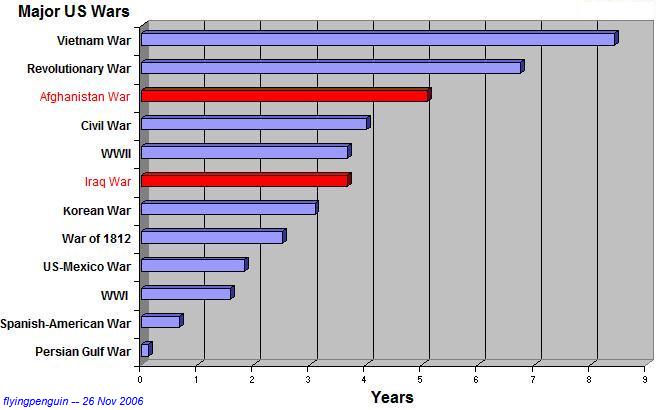I have seen innumerable articles about the shortness or length of American wars, and heard the Bush administration comments about the War on Terror being an unusually long one, but I have yet to come across a bar graph putting it all in perspective. Since I find a visual helpful, I threw something together to show how (as of today) the War in Iraq and Afghanistan have climbed the rungs of time. Thought I would share (click on it to enlarge):

Of course the start of the US engagement in Vietnam is a little fuzzy if you count the tens of thousands of “advisors” and special operations teams sent by Eisenhower. Some say the whole war was as short as 90 months but I used 101 months as recently posted by the AP, which I have to admit ignores the crucial twenty four months after Kennedy officially sent in American troops. All of these timelines for Vietnam are still well-shy of the 18 years suggested by others. I would add the LSU calculations of total casualties and financial costs to my graph as well, but as you can see above the dates are hard enough to pin down…
< ------------Casualties------------>
[-----Deaths---] < -----Percentages-----> Duration
Conflict Enrolled Combat Other Wounded Total Ratio KIA Dead Casualty Months KIA/Month
Revolutionary War 200.0 4,435 * 6,188 10,623 2.4 2.2% 2.2% 5.3% 80 55
War of 1812 286.0 2,260 * 4,505 6,765 3.0 0.8% 0.8% 2.4% 30 75
Mexican War 78.7 1,733 11,550 4,152 17,435 1.3 2.2% 16.9% 22.2% 20 87
Civil War: Union 2,803.3 110,070 249,458 275,175 634,703 1.8 3.9% 12.8% 22.6% 48 2,293
Confederate 1,064.2 74,524 124,000 137,000 + 335,524 1.7 7.0% 18.7% 31.5% 48 1,553
Combined 3,867.5 184,594 373,458 412,175 + 970,227 1.7 4.8% 14.4% 25.1% 48 3,846
Spanish-American War 306.8 385 2,061 1,662 4,108 1.7 0.1% 0.8% 1.3% 4 96 &
World War I 4,743.8 53,513 63,195 204,002 320,710 2.7 1.1% 2.5% 6.8% 19 2,816
World War II 16,353.7 292,131 115,185 670,846 1,078,162 2.6 1.8% 2.5% 6.6% 44 6,639
Korean War 5,764.1 33,651 * 103,284 136,935 4.1 0.6% 0.6% 2.4% 37 909
Vietnam War 8,744.0 47,369 10,799 153,303 211,471 3.6 0.5% 0.7% 2.4% 90 526
Gulf War 2,750.0 148 145 467 ^ 760 2.6 0.0% 0.0% 0.0% 1 148
Combat deaths refers to troops killed in action or dead of wounds. Other includes deaths from disease, privation, and accidents, and includes losses among prisoners of war. Wounded excludes those who died of their wounds, who are included under Combat Deaths. Ratio is the proportion of wounded in action to combat deaths. Note that the wounded figures do not include cases of disease. Under Percentages, KIA refers to the percent of those enrolled killed in action, Dead to the percent dead from all causes, and Casualty to the percent killed or injured. KIA/Month, killed in action per month, gives a fair indication of the intensity of combat
Notes:
* Non-battle deaths not known for these wars.
+ Confederate non-battle deaths and wounded estimated.
& Actually only six weeks of sustained combat.
^ There was only one month of combat.
I also did not put the “War on Drugs” on the chart but I do wonder if that would help put something like the War on Terror in perspective? According to the Boston Globe, it is now decades old and the results have not been quite what was intended…
Fact: In the three decades since Nixon declared substance abuse a “national emergency,” the United States has focused on curbing supply and demand for illegal drugs. Currently, nearly half a million people in this country are behind bars for drug crimes (mostly trafficking). Yet the domestic drug market remains free-flowing. Classic economic theory states that when supply goes down, the price of a commodity goes up and its purity declines. With hard street drugs, the inverse has occurred. They’re dramatically cheaper and purer than they were 25 years ago — suggesting greater supply and easy access. Adjusted for inflation, cocaine prices have dropped by more than half since 1980. A bag of heroin goes for little more than a gallon of gas or a six-pack of water.
Thirty-five years and drugs flow more freely and for less cost? Wonder if anyone has readily available data on the suspected causes of terrorist activity such as displacement, persecution or perhaps fundamentalism. Ah, the definition of terrorism is tricky. Maybe it would be easier to try and quantify the sale of illegal arms relative to the number of terrorist factions, or the supply of small arms and the number of incidents caused by paramilitary groups and militias? I would go with something like this in the CS Monitor, but then again it seems to come right back around to the Iraq War…
In a report to be released next week, US government figures will show that the number of terrorist attacks in the world jumped sharply in 2005, totalling more than 10,000 for the first time. That is almost triple the number of terrorist attacks in 2004 — 3,194. Knight Ridder’s Washington bureau reports that counterterrorism experts say that there are two reasons for the dramatic increase: a broader definition of what consitutes a terrorist attack, and the war in Iraq.
[…]
“Roughly 85 percent of the US citizens who died from terrorism during the year died in Iraq. The figures cover only noncombatants and thus don’t include combat deaths of US, Iraqi and other coalition soldiers.”
Their “broader definition” of terrorism apparently now includes attacks that do not include more than one nationality. In other words McVeigh’s bombing would not have been classified as terrorism under the old rules since he was American and attacking Americans. The CS Monitor article also has some other useful references to defining the War on Terror, however long it has lasted.
